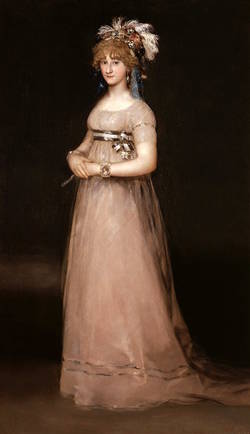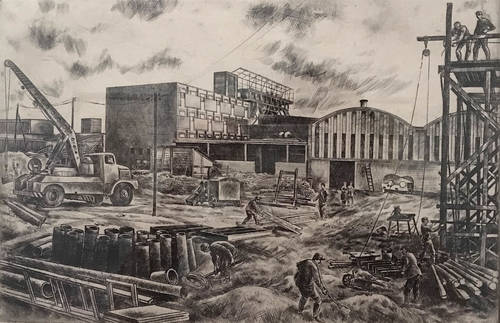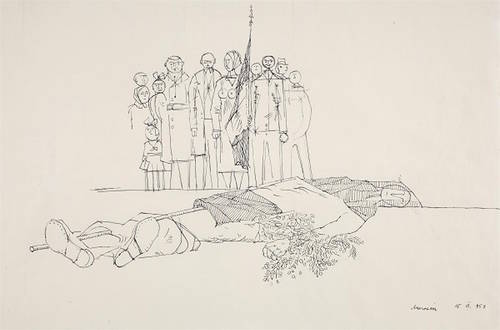Florence, in these weeks before the arrival of the Easter crowds, is cold but relatively empty and there are two exhibitions well worth seeing: 14th-century fabrics in the Galleria dell’Accademia, and 18th century paintings in Palazzo Pitti.

The first exhibition (Tessuto e ricchezza a Firenze nel trecento. Lana, seta, pittura; on until 15th April), devised and curated by the Galleria dell’Accademia director Cecilie Hollberg, is particularly enjoyable. You can book to see it, but at this time of year, particularly in the late afternoon, you can often just walk in and there will be no queue. The show links the fabric industry—which gave the medieval city its wealth—to the designs of the backcloths in gold-ground paintings, and later to the dresses worn by the figures depicted by some of the early masters of 14th-century Florentine painting.
The floor in the first room reproduces the intricate mosaic pavement of the church of San Miniato al Monte (the most beautiful of all Florence’s medieval churches), a subtle reference to the importance of pattern to the craftsmen of the time. The beautiful statute-books of the two ‘Arti’ or guilds which represented the cloth-workers, those who dealt with wool and those who (later) dealt with silk, are exhibited here. There are interesting documents, including some letters from the archives of Datini (the famous ‘Merchant of Prato’) with samples of wool pinned to them. The first exhibit, set to astonish us, is a child’s wool dress, only preserved because it comes from icy climes, lent by the National Museum of Denmark. Another survival is a piece of a woollen hood, alleged to have been worn in the 13th century by the nun St Umiltà and conserved as a holy relic in the monastery of Vallombrosa in the hills above Florence.
The first painting we see is a touching panel Madonna and Child (who reaches up to hug his mother) from the church of San Remigio. It dates from c. 1290 (and here given a new attribution). A rare occasion to see this masterpiece well-lit and at close range. Almost all the other paintings—carefully chosen to show how the precision with which fabrics were reproduced in paint—are from the Accademia itself (including some brought out of storage). An exception is Giovanni Baronzio’s Baptism of Christ, on loan from the National Gallery of Art in Washington and chosen because of the beautifully patterned towel held up by angels (who are dressed in garments to match). Very few paintings are attributed to this artist from Rimini, and none are to be seen in Florence.
The pieces of fabric exhibited come from Lyon, Prague, Brussels and Berlin, as well as from Florence’s Bargello. The silks, in gorgeous colours, are very fine, many Islamic in origin. Since they are often fragmentary, the complete designs have been recreated on the wall behind them. It has been discovered that the large funeral shroud found in the tomb of Cangrande I, the most famous member of the Della Scala family, who died in Verona in 1329, was made in central Asia. A dalmatic from northern Germany is made up of five different fabrics, all from China. Two works of the 1370s by Jacopo di Cione are decorated with birds and tortoises with the Child dressed in gorgeous orange and gold swaddling clothes. An end room has a delightful video installation with ‘animated’ paintings: it takes as its subject the report of a magistrate who in the 14th century noted down the excesses he found in dress in order to damn the vice of ‘unseemly vanity’, vividly demonstrating how fabrics impinged also on the social life of the town. The ‘film’ is shown alternately in English and Italian (and the concise English labelling throughout the exhibition is excellent).
In the last room there is a very well-preserved silk jacket (made with the pourpoint technique), traditionally supposed to have been worn by Charles of Blois at his death in 1364: he was killed by his uncle (and rival for the Duchy of Brittany), John de Montfort, in the Hundred Years’ War. After the battle it was preserved as a relic of the saintly Charles until it was lost during the French Revolution. It only turned up again in 1924 when it was donated to the Musée des Tissus in Lyon who have lent it to the exhibition. The material comes from Iran or Iraq. This type of military jacket, with numerous buttons, had already become fashionable in Florence a few decades earlier and must have been particularly becoming when worn by a young knight.
One of the last exhibits is a bolt of vermillion-coloured velvet with a pattern of gold discs (lent by the Bargello), which seems to be the very same cloth as the one held up by the angels in the background of Starnina’s Coronation of the Virgin (1405–10), lent by the Galleria Nazionale di Parma. Seeing the two side by side clearly shows how skilfully Starnina painted the folds and rucks in the large piece of cloth: we are now at the beginning of the Renaissance.
(The large catalogue is extremely scholarly, if expensive).
On the other side of town, Eike Schmidt, director of the united Uffizi and Pitti galleries), has put together a tiny exhibition (The Eighteenth century: A selection; on until April) in one of the rooms of Palazzo Pitti. This is a period less known for its artistic output in Florence. Schmidt has made a selection of just 17 paintings (from the 500 or so in the Gallery’s collection) of non-religious subjects to illustrate the variety of works produced at that time. He has also taken it is an opportunity to begin to dismantle the ‘Blue Rooms’ in the Uffizi, which previously were dedicated to foreign schools. Schmidt’s aim is to integrate the collections to show the Medici grand-dukes collected both Italian and foreign works, notably by Dutch and Spanish painters. Indeed the most beautiful of the works in this exhibition is Goya’s full-length portrait of the Countess of Chinchón, painted around 1801. Displayed between the academic portraits of Vittorio Alfieri and his mistress, the Countess of Albany, by Fabre, which date from only a few years earlier, it demonstrates the direction painting was to take by the end of the century. Townscapes of Rome, Naples, Florence and Venice (including a stunning view of the Grand Canal by Canaletto) show the very special interest in travel in this century. Thomas Patch is also represented, with a view of Ponte Santa Trinita, looking downstream. The fashion for exotic scenes and dress can be seen in a portrait by Etienne Liotard and in small Turkish genre panels. Another (very rare) genre scene is the little painting in oil on copper by Giuseppe Maria Crespi, which shows the painter himself twice over: in a self-portrait in the background, and in the foreground pulling his children along in a wooden contraption as his wife looks on, laughing. From the middle of the century come a pair of portraits by Chardin of a girl with a shuttlecock and racquet and a boy at a card table. An exemplary show, to remind us of a period often overlooked in Florence.
Reviewed by Alta Macadam. For details of her Blue Guide Florence, see here.








